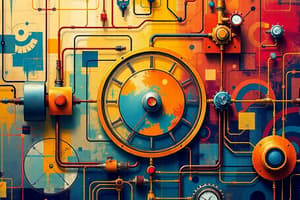Podcast
Questions and Answers
A closed-loop control system can maintain stability in a system only when there are no disturbances or changes.
A closed-loop control system can maintain stability in a system only when there are no disturbances or changes.
False (B)
The primary function of a thermostat in an air conditioner is to regulate the compressor's speed.
The primary function of a thermostat in an air conditioner is to regulate the compressor's speed.
False (B)
Closed-loop control systems are less reliable and resilient in real-world applications due to their sensitivity to uncertainties and variations.
Closed-loop control systems are less reliable and resilient in real-world applications due to their sensitivity to uncertainties and variations.
False (B)
The feedback loop in a closed-loop control system is only used to monitor the system's output.
The feedback loop in a closed-loop control system is only used to monitor the system's output.
A closed-loop control system can reject disturbances that impact the system's performance.
A closed-loop control system can reject disturbances that impact the system's performance.
The air conditioner's temperature regulation is an open-loop control system.
The air conditioner's temperature regulation is an open-loop control system.
Closed-loop control systems are only used in systems that do not require precision control.
Closed-loop control systems are only used in systems that do not require precision control.
The error signal in an air conditioner's control system is the difference between the desired temperature and the surrounding temperature.
The error signal in an air conditioner's control system is the difference between the desired temperature and the surrounding temperature.
Closed-loop control systems are less stable than open-loop control systems.
Closed-loop control systems are less stable than open-loop control systems.
The thermostat in an air conditioner is an example of an actuator.
The thermostat in an air conditioner is an example of an actuator.
Flashcards are hidden until you start studying
Study Notes
Control Systems Overview
- Control systems are essential for stability, accuracy, and efficiency in complex systems.
- They continuously monitor and adjust system variables based on output performance.
Types of Control Systems
- Two primary categories exist:
- Open-loop Control
- Closed-loop Control
Open-loop Control
- Control actions are based solely on reference inputs without feedback from system output.
- Example: Automatic washing machines operate for a set time without adjusting for cleanliness.
- Characteristics:
- Simple and easy to model.
- Less reliable and low accuracy.
- Not robust against disturbances and uncertainties.
- Examples include traffic lights and TV remotes.
Closed-loop Control
- Also known as feedback control systems, these systems use output feedback to adjust inputs.
- They compare actual output with desired reference values to compute necessary control actions.
- Example: Air conditioners monitor output temperature and adjust to maintain desired conditions.
- Characteristics:
- Complex and hard to model.
- High reliability and accuracy.
- Robust to disturbances and uncertainties.
- Examples include refrigerators and toasters.
Improved Control Performance
- Closed-loop systems enhance efficiency, productivity, and quality through better control compared to open-loop systems.
Components of Closed-loop Control Systems
- Input: Desired state or reference value the system aims to achieve.
- Sensor: Devices measuring the current state or output of the system (e.g., air conditioner sensing room temperature).
Advantages of Closed-loop Control
- Stability: Continuous monitoring and adjustment ensure the system remains stable amid disturbances.
- Robustness: Capable of handling uncertainties and variations effectively through feedback adjustments.
- Disturbance Rejection: Effectively mitigates disturbances impacting system performance.
Studying That Suits You
Use AI to generate personalized quizzes and flashcards to suit your learning preferences.




